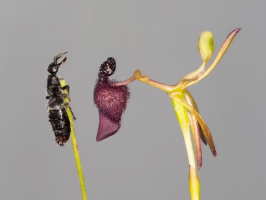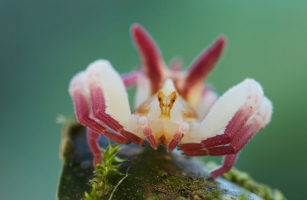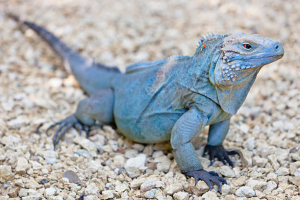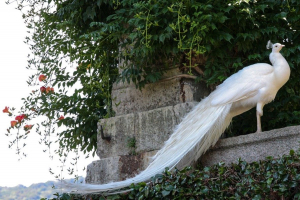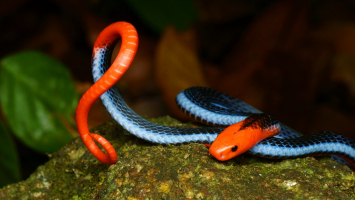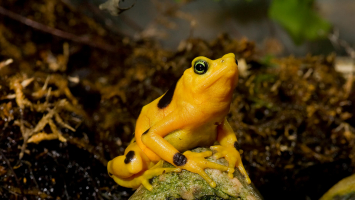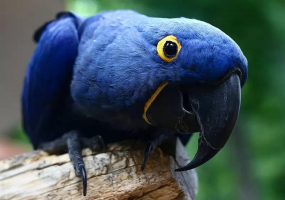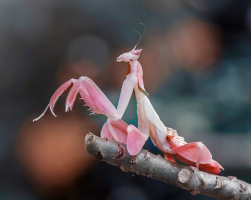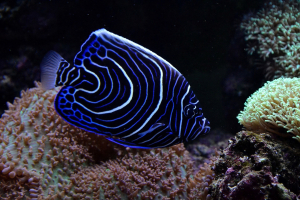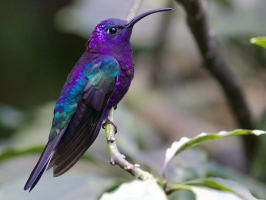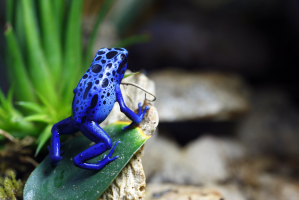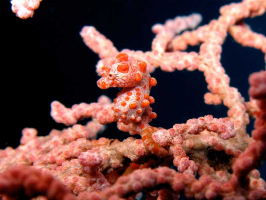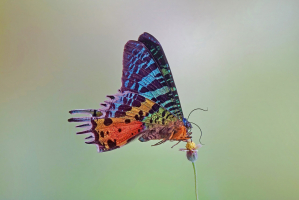Top 10 World's Most Beautiful Jellyfish
Jellyfish are free-swimming marine animals. They are found in hundreds of distinct species, and more are constantly being discovered. Every ocean, from the ... read more...surface to the deep oceans, contains jellyfish. Some jellyfish species live in freshwater. Jellyfish are named one of the major wonders of marine life because of their beauty and their attractive look which makes people fond of their beauty. Here is a list of the most beautiful jellyfish in the world, let's find out!
-
The Atolla Jellyfish (Atolla wyvillei) or Coronate medusa, is a species of deep-sea crown jellyfish (Scyphozoa: Coronatae). Oceans all across the world are home to it. It normally has 20 marginal tentacles and one larger-than-the-other hypertrophied tentacle. It is believed that this lengthy trailing tentacle makes it easier to capture prey. It is bioluminescent in this species. When threatened, it will flash repeatedly in an effort to attract predators who will be more interested in the assailant than it is in itself. The animal acquired the moniker "alarm jellyfish" as a result of this.
Atolla wyvillei has a bell-shaped body and many somewhat long tentacles that run the length of the bell. The bell's diameter ranges from 20 to 174 mm. Its coloring is a rich shade of red, like many other kinds of mid-water creatures. The digestive, respiratory, circulatory, and central nervous systems of these jellyfish are all absent. It has no brain since it has no central nervous system.
N S R Science & Technology & Natural News creation 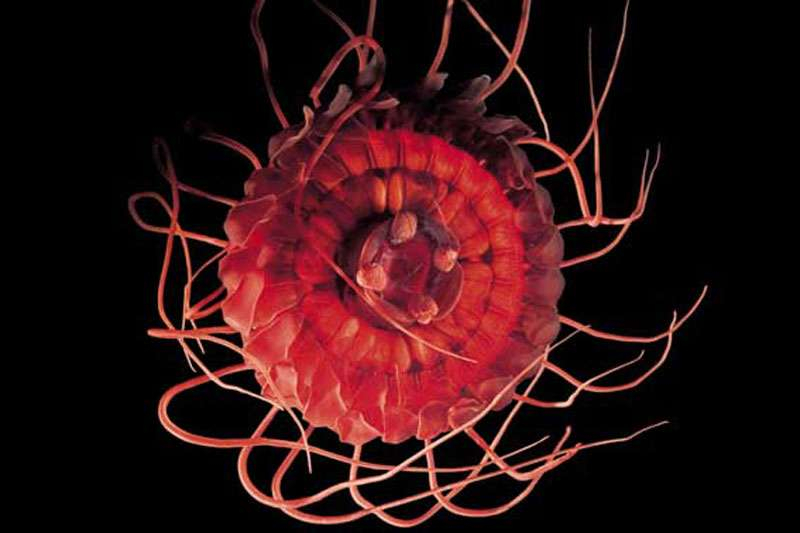
Futura-Sciences -
The marine creature known as Blue Button (Porpita porpita), is made up of a colony of hydroids and can be found in the Mediterranean Sea and the eastern Arabian Sea as well as the warmer, tropical, and subtropical seas of the Pacific, Atlantic, and Indian oceans. It belongs to one of the two genera that make up the cnidarian suborder Chondrophora, which also contains Velella. The siphonophores, which include the Portuguese man of war, or Physalia physalis, are more well-known and share characteristics with the chondrophores. Each apparent individual, despite looking superficially like a jellyfish, is actually a colony of hydrozoan polyps. Because anemones, corals, and jellyfish are members of the phylum Cnidaria, which also includes the taxonomic class Hydrozoa, this explains why they have a similar appearance.
The blue button, which lives on the ocean's surface and has two primary components - the float and the hydroid colony - can get as big as 30 mm in diameter. The spherical, nearly flat, and firm golden brown float is about an inch broad. The floating organ, which also has pores that allow it to communicate with other P. porpita organisms and its surroundings, is what allows the organism to travel vertically. The hydroid colony mimics jellyfish tentacles and can range in color from vivid blue turquoise to yellow. Each strand has many branchlets, and the distal end of each nematocyst - a knob of stinging cells - is where they all stop.
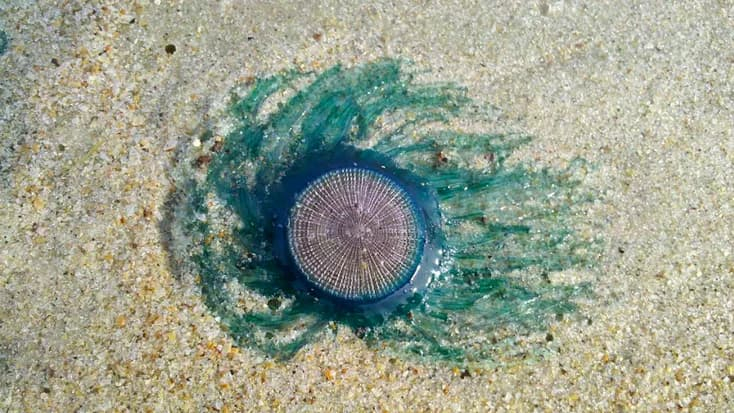
St. Augustine Record 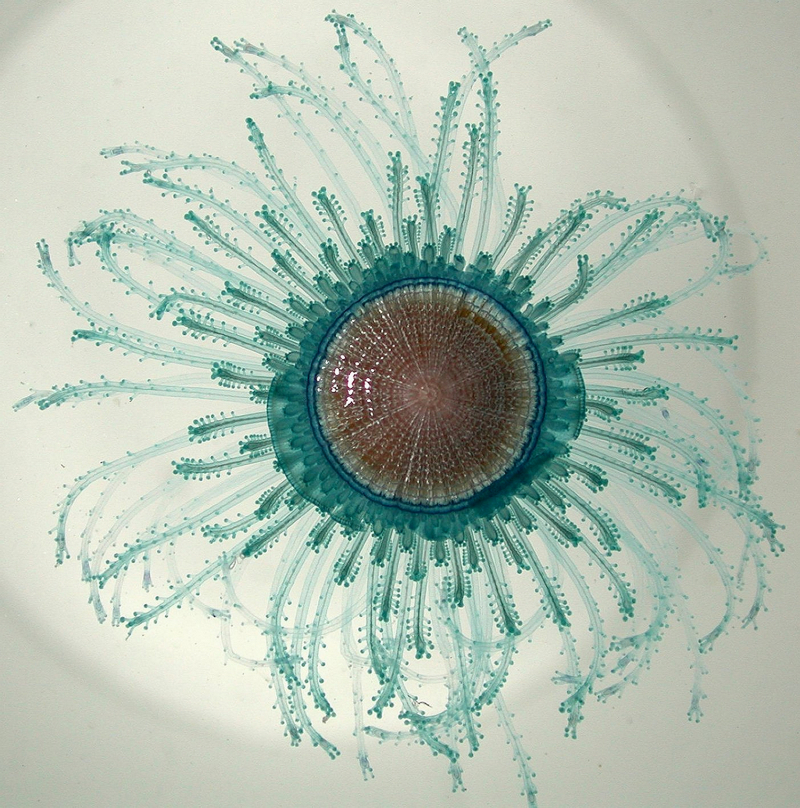
-
Diplulmaris Antarctica is a species of Antarctic jellyfish in the family Ulmaridae. This species is found in Antarctica including the Antarctic Peninsula in continental shelf waters near the surface. Copepods, euphausiid larvae, medusae, ctenophore, fish larvae, and molluscan pteropods like Clione Antarctica and Limacina Antarctica are among the food sources for Diplulmaris Antarctica.
The diameter of this species can reach 18 cm (7 inches). The frontal lobe and 16–48 laterally compressed white tentacles of Diplulmaris Antarctica are both white. It possesses frilled oral arms and stomach gastrodermis that are both reddish-orange in color. Hyperiella dilatata typically infests this jellyfish. These hyperiid amphipods, which are visible as white specks on the bell's surface, don't seem to be feeding on the medusa.
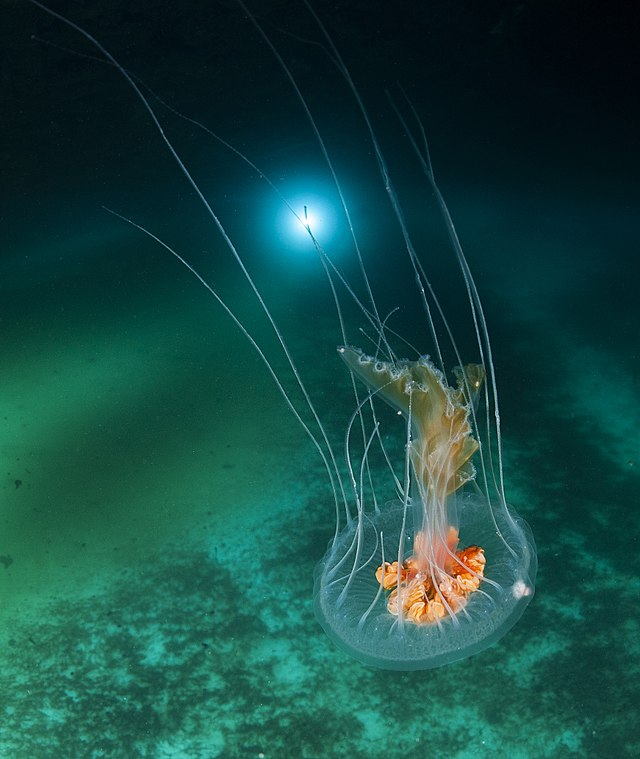
Wikipedia 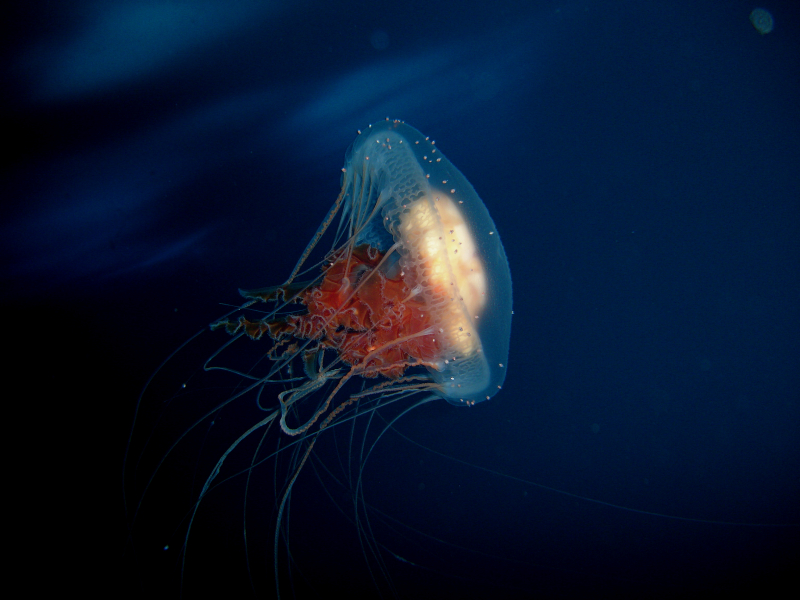
Wikimedia Commons -
A jellyfish species from the Indo-Pacific coast is called the Jelly Blubber (Catostylus mosaicus), also called the blue blubber jellyfish. It is the jellyfish that is most frequently seen around the eastern coast of Australia, and enormous swarms can occasionally be seen in estuary waters. It eats mostly plankton, little fish, a few crustaceans, and tiny ocean water particles.
The jelly blubber's enormous bell is often blue farther north in Australia than it is in Sydney waters, where it is typically creamy white or brown. Symbiotic algae plant cells within the jellyfish's body are where the colors come from. The underside does not appear to have a mouth, but each arm has a small aperture that allows food to enter the stomach. Additionally equipped with stinging cells, the tentacles can seize tiny crustaceans and other plankton. It may expand to a 35cm width.
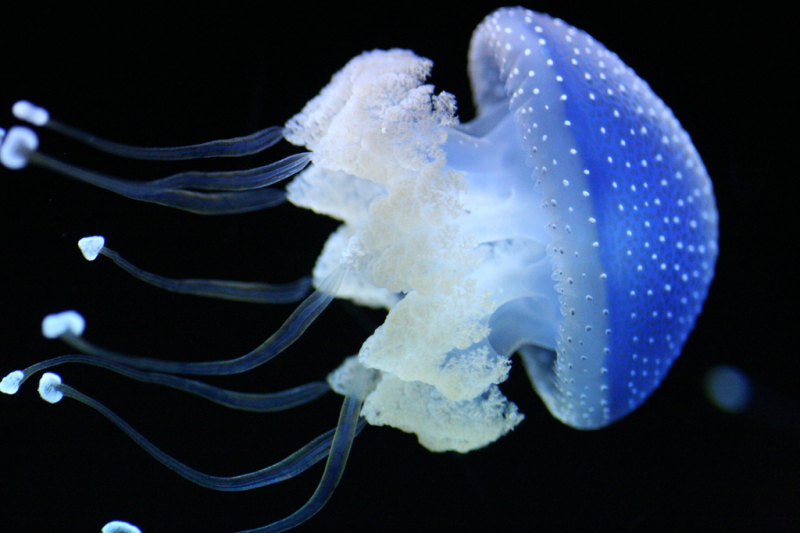
iNaturalist Deep Marine Scenes -
The cabbage head jellyfish, commonly referred to as the Cannonball Jellyfish (Stomolophus Meleagris), is a species of jellyfish in the Stomolophidae family. Its common name comes from the fact that it resembles a cannonball in terms of size and shape. Its bell, which has a dome form and a diameter of up to 25 cm (10 inches), can occasionally have brown pigment applied to the rim in the Atlantic and Gulf of Mexico. This jellyfish can also have blue pigment in the Pacific. There is a collection of oral arms under the body that surrounds the mouth. These limbs serve as a means of propulsion and a tool for grabbing prey.
Cannonballs are prominent from North America's eastern seaboard all the way to Brazil but are also found in parts of the Pacific. Cannonballs primarily consume all varieties of red drum larvae as well as zooplankton like veligers. They coexist together with the large spider crab, which also consumes the tiny zooplankton. The crab consumes both the cannonball-captured prey and the medusae of the jellyfish as food.
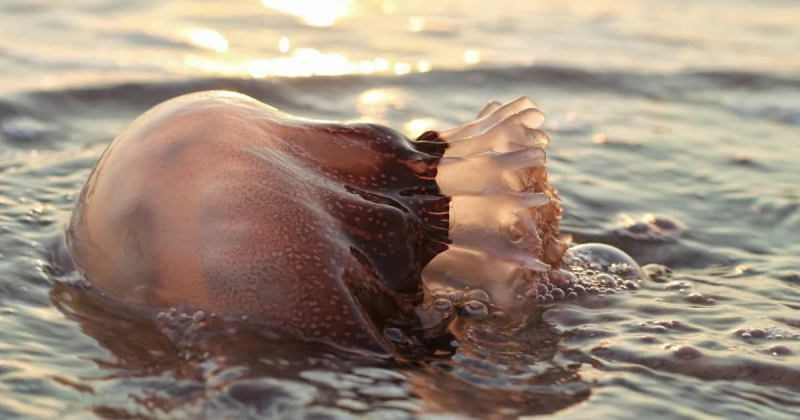
Golden Isles Magazine 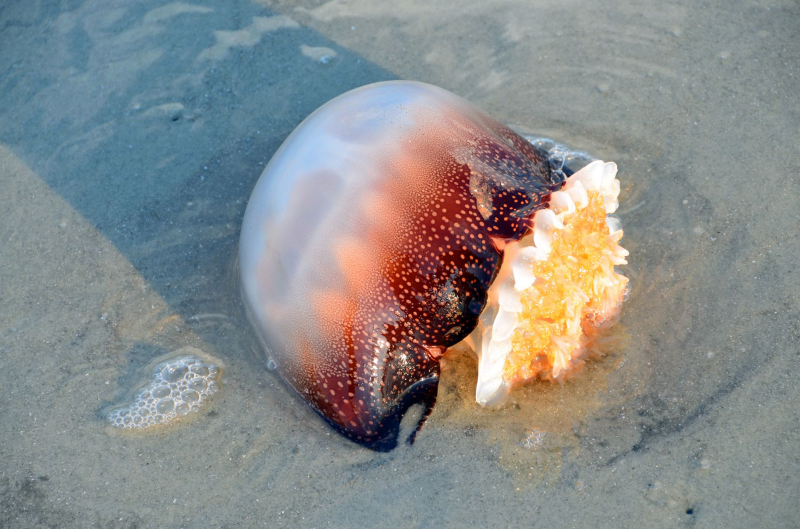
ThoughtCo -
The Purple-Striped Jelly (Chrysaora colorata), is a species of jellyfish that exists primarily off the coast of California from Bodega Bay to San Diego. They have been observed to consume a wide range of species, including fish eggs, copepods, hydromedusae, Siphonophora, and Cladocera. When a prey meets a marginal tentacle, the tentacle rapidly releases stingers to immobilize the prey and bends inward toward the closest oral arm. Prey is carried to the gastrovascular cavity (GVC) by the oral arm, which is also employed to capture immobile prey. Although it is uncommon, this jellyfish may sting people very badly.
The purple-striped sea nettle is another name for the purple-striped jelly. When it is very young, it has a pinkish hue and lengthy, dark maroon tentacles. The dark maroon hue of the tentacles begins to fade at the mature stage, and the purple now appears as stripes on the bell. The four frilly oral arms of grownups will grow longer as they get older. As the jellyfish ages, its oral arms tend to vanish, its tentacles expand, its purple stripes start to darken, and it develops pale tentacles.
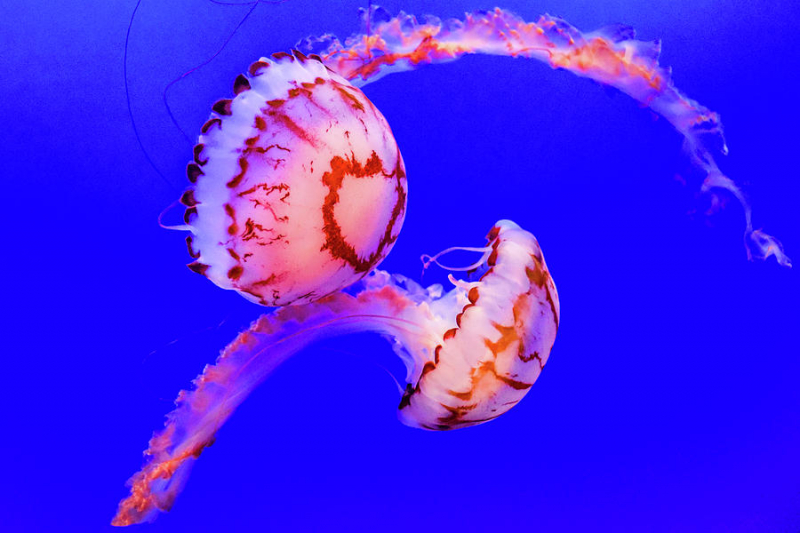
Fine Art America 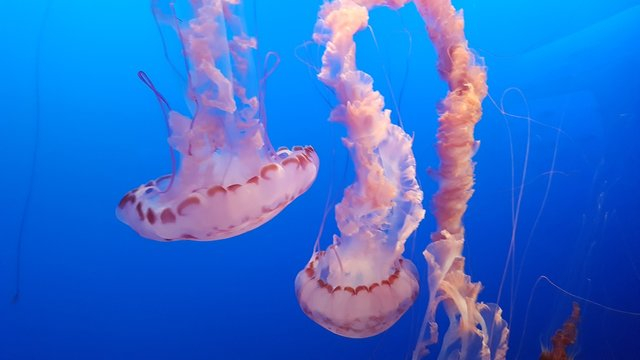
Adobe Stock -
The White-Spotted Jellyfish (Phyllorhiza punctata) is a species of jellyfish, also known as the floating bell, Australian spotted jellyfish, or brown jellyfish. Although it has been widely introduced elsewhere, its original range is the western Pacific from Australia to Japan. It mostly consumes zooplankton for food. P. punctata bells typically measure up to 50 centimeters (20 inches) in diameter, however, one that was 72 cm (28 inches) broad and possibly the largest ever discovered was discovered on Sunset Beach in North Carolina in October 2007.
A medusa stage (adult) and a polyp stage make up the two stages of the life cycle of true jellyfish (juvenile). The female jellyfish gathers the sperm into her mouth, where she holds the eggs, during the medusa stage when male jellyfish release sperm into the water column. Larvae are generated during fertilization, after which they depart from their mother and land on the ocean floor. Once at the bottom, a polyp shape appears, which then divides into further polyps to reproduce asexually. They are not thought to pose a hazard to people and only have weak venom. They have a barely perceptible sting that can be treated with weak acid.
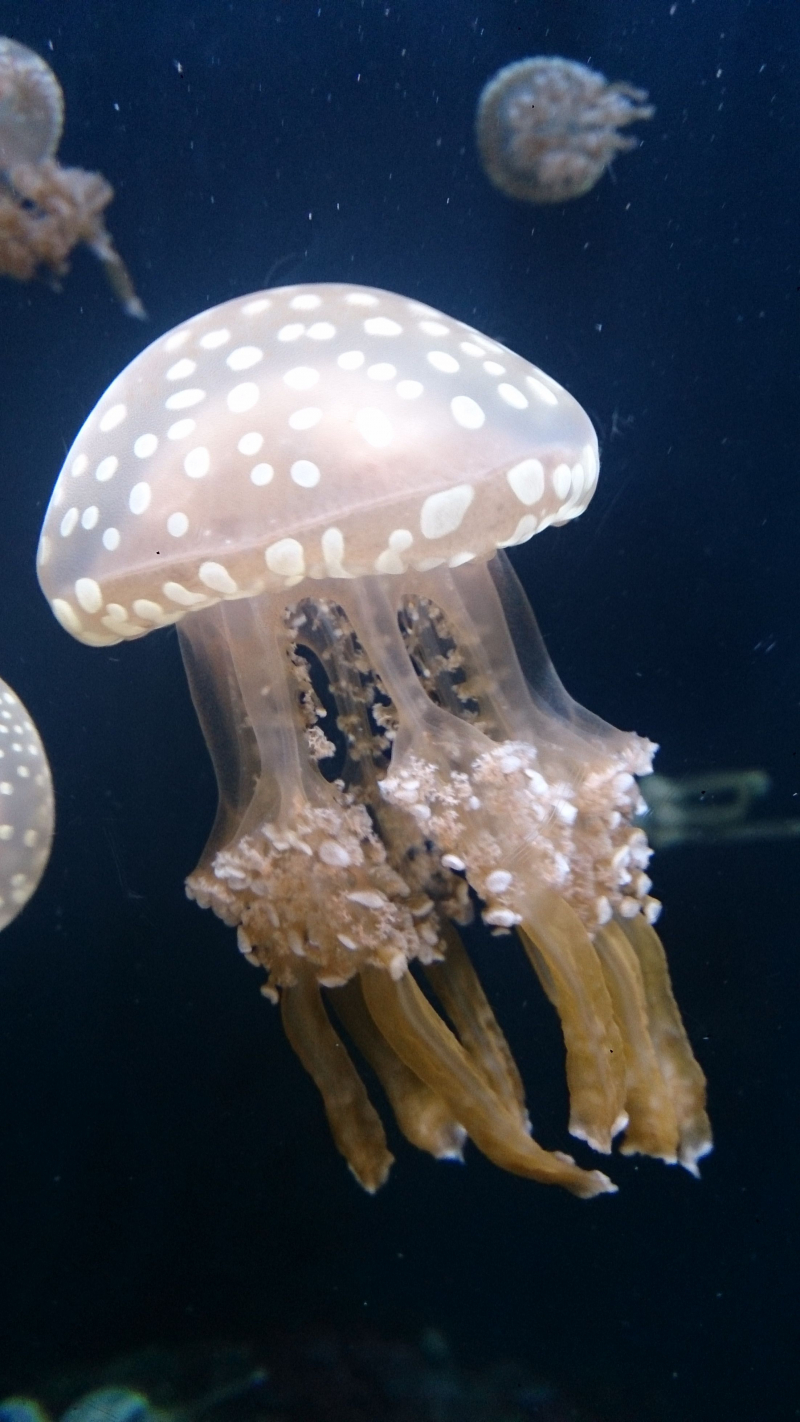
Wikimedia Commons 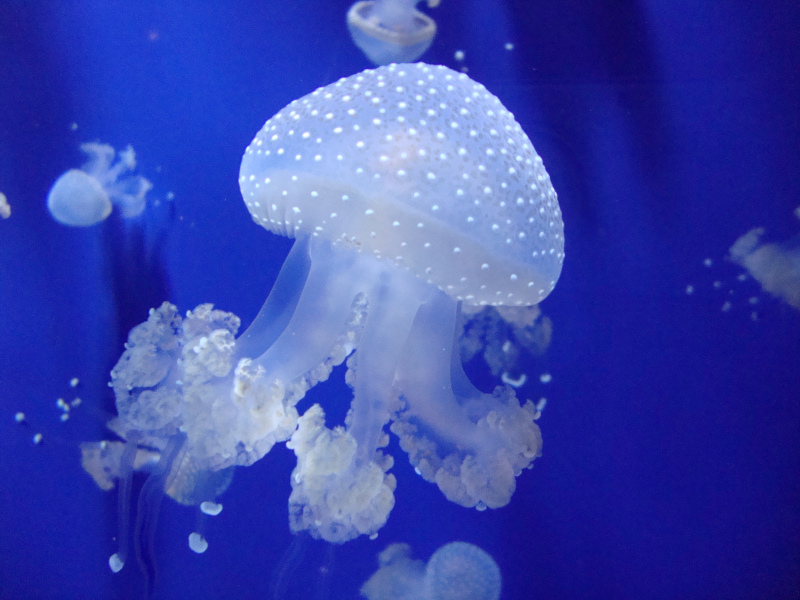
Wikimedia Commons -
One of the biggest species of jellyfish is the Lion's Mane Jellyfish (Cyanea capillata), also known as the enormous jellyfish, arctic red jellyfish, or the hair jelly. It only inhabits the arctic, northern Atlantic, and northern pacific oceans' frigid, boreal waters. It is widespread in the North Sea, Irish Sea, English Channel, and waters around western Scandinavia south to Kattegat and resund. Additionally, it might float toward the southwest corner of the Baltic Sea (where it cannot breed due to the low salinity).
This jellyfish gets its name from the flamboyant, trailing tentacles that resemble a lion's mane. They can reach bell diameters of over 2 m (6 ft 7 inch), however, those found in lower latitudes are considerably smaller than their far northern cousins, with a bell of about 50 cm (20 inches). The manes of very young lions are occasionally white, while those of adults are red and get darker with age. Juveniles have a lighter shade of orange or brown. The bell of the lion's mane jellyfish is divided into eight lobes that resemble an eight-pointed star, as opposed to the round bell of most jellyfish like the moon jelly. Each lobe has roughly 70 to 150 tentacles, which are arranged in four fairly distinct rows.
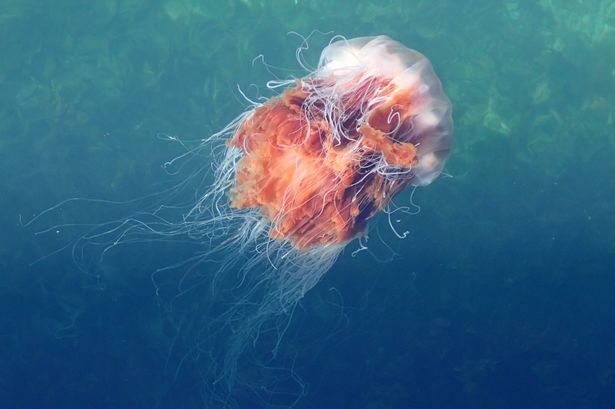
Irish Mirror 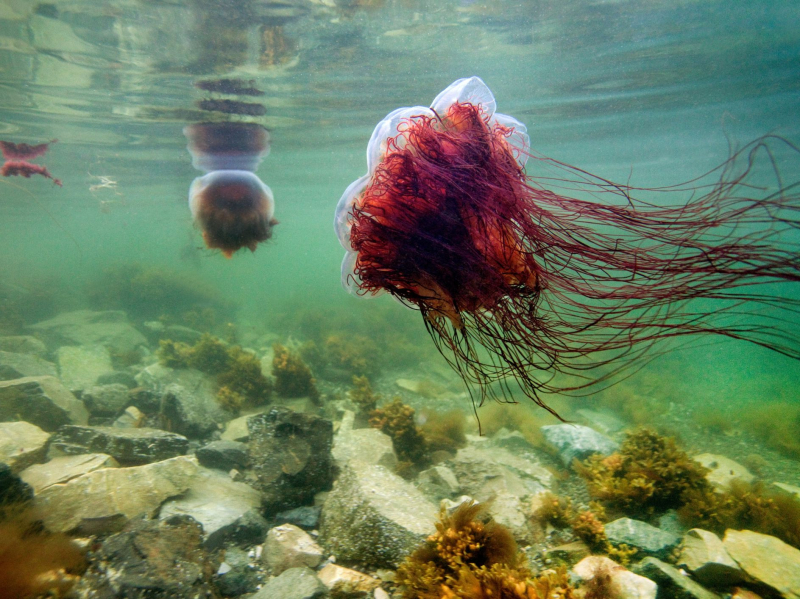
ThoughtCo -
A species of the genus Aurelia is called Aurelia aurita, often known as the common jellyfish, Moon Jellyfish, moon jelly, or saucer jelly. Since all of the genus species are quite similar to one another and cannot be distinguished without genetic testing, most of what is written below is applicable to all of the genus species. The most popular technique for identifying the species entails choosing a jellyfish from a harbor with a tool, typically a drinking glass, and taking a photo of the item. As a result, they can be returned to their original home immediately after being released into the harbor.
The jellyfish can be identified by its four horseshoe-shaped gonads, which are visible through the top of the bell and are almost fully translucent. The jellyfish is typically approximately 25-40 cm (10-16 inches) in diameter. With the use of its tentacles, it gathers medusae, plankton, and mollusks to transport into its body for digestion. Even when swimming, it can only move in a very limited manner and drifts with the stream.
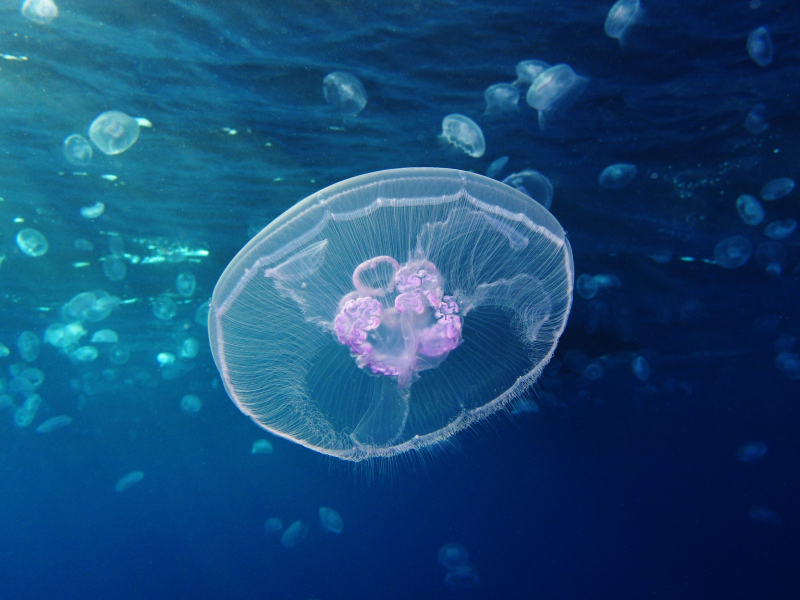
Wikipedia 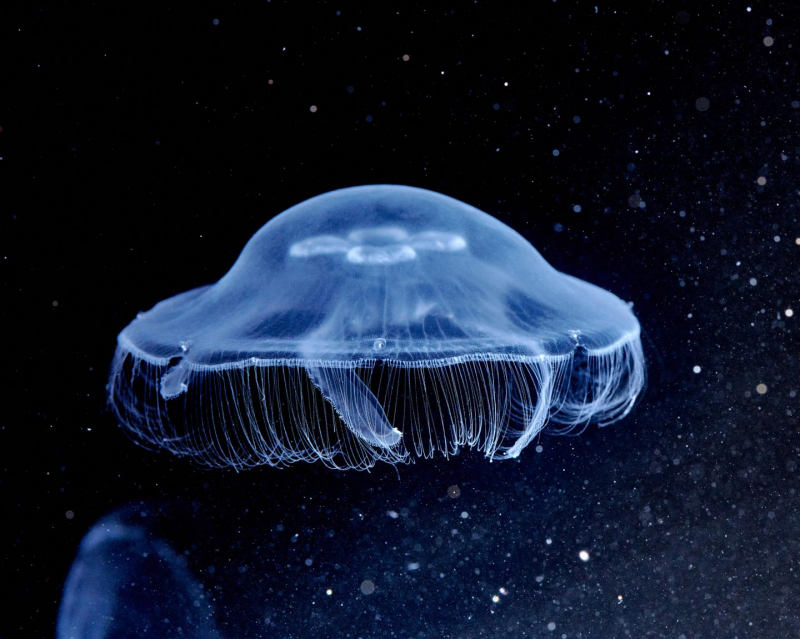
EurekAlert -
The Crystal Jelly (Aequorea victoria), is a bioluminescent hydrozoan jellyfish, or hydromedusa. From the Bering Sea to southern California, they can be found along the Pacific Ocean's west coast of North America. The pelagic organism that makes up the medusa portion of the life cycle budded off a bottom-dwelling polyp in late spring. In the eastern Pacific Ocean, medusae can be found floating and swimming both close to shore and offshore; this species is particularly prevalent in Puget Sound.
They have a nearly totally transparent and colorless body, a strongly contractile mouth, and a manubrium at the center of up to 100 radial canals that extend to the bell border. Up to 150 unequal tentacles encircle the bell border in fully-grown specimens. Nematocysts found in the tentacles help capture prey, but they have little impact on people. The gonads for sexual reproduction are often present in specimens larger than 3 cm; they span the majority of the radial canals and may be seen in the images on this page as whitish thickenings.
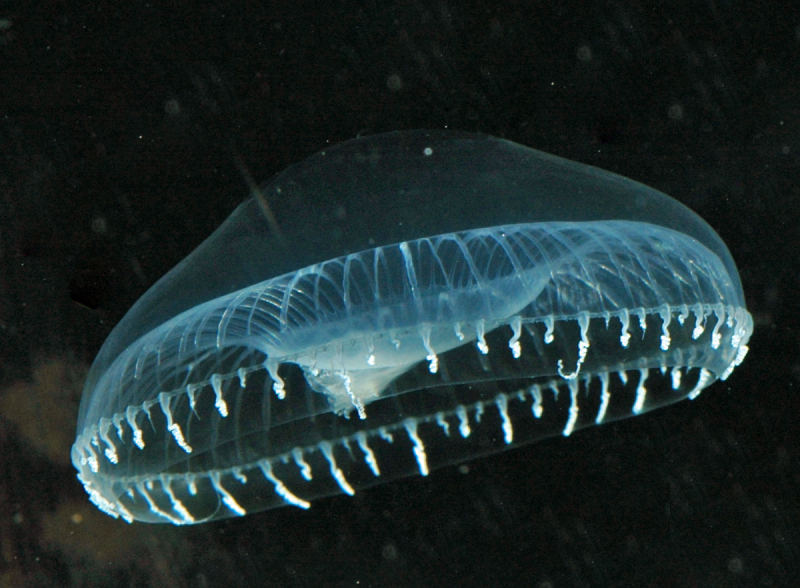
Wikipedia 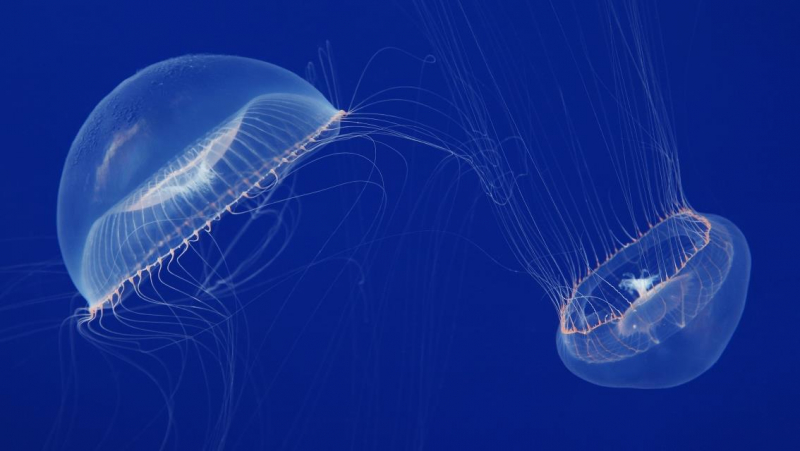
Marine Learning












